1606
The first leap into space US
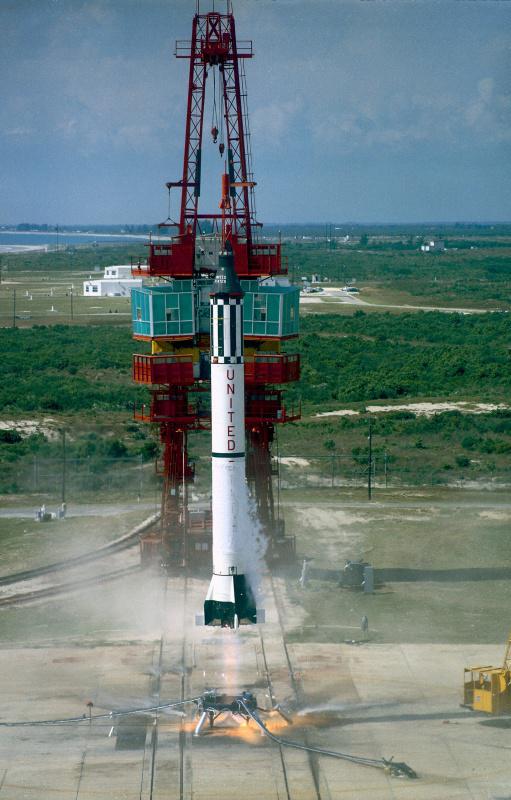
Well, when some historical event is equipped with cameras from different angles, so you can see how that happened. Even better, when the event is not very long, so that from the Chronicle did not become boring. According to these two parameters, the first American space flight May 5, 1961 is clearer Gagarin's flight - on «Mercury-Redstone 3" were two cameras, one of which is rented astronaut, and the second - the dashboard. And the fact that the flight was suborbital, meant that it will last only fifteen minutes, in contrast to the relatively long orbital flight Gagarin 108 minutes. Space enthusiasts have even made a few clips with the reconstruction of the flight. And the fact that I like, I added Russian subtitles.
A little about «Mercury» h4> The "Mercury" - the first manned flight into space in the United States. Its mission was to create a manned spacecraft and to investigate the possibility for a person to be in space. According to the program "Mercury" was committed six manned flights - two suborbital and orbital four. The first suborbital flight was to some extent a necessary measure - the United States was slow to develop ICBM abbr> «Atlas", which was to withdraw the ship to "full" orbit. So I had to improvise - to take less powerful, but mastering IRBM abbr> «Redstone" and instead make orbital flight "jumps" into space. In principle, the suborbital flight made it possible to feel ten times longer than an airplane, weightlessness (5 minutes versus 30 seconds) to "meet" with her, and there were even plans to introduce each astronaut weightlessness in suborbital flight to the orbital flight. But the space race upset all the plans - the success of Gagarin's flight sharply reduced the value of sub-orbital flights.
Flight «Mercury-Redstone 3» h4> Mission «Mercury-Redstone 3" - is the first manned suborbital spaceflight United States and the world's first suborbital manned spaceflight. It was held May 5, 1961, and lasted only 15 minutes. Pilot - Alan Shepard.
ship h5> 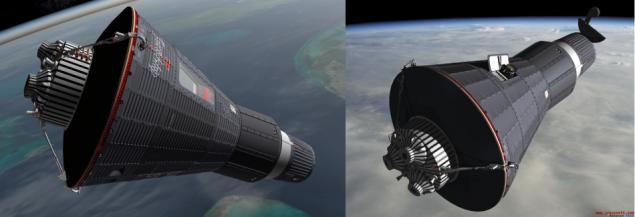
left - top view, right - the view below, is seen released periscope i>
Ship "Mercury" - Single, made under the scheme of a truncated cone. In the narrow part of the ship were parachutes (brake, main and reserve), sensors horizon, escape hatch. In the central part of the ship was located astronaut, devices and consumables tanks - hydrogen peroxide system for orientation of helium to boost oxygen for respiration. Outside the broad side of the ship is air landing shock, heat shield (beryllium for suborbital flights and fiberglass for orbital flight) and a bunch discharged brake motors. The ship has a length of 3 m 3, a diameter of 1 8 m, a mass of up to 1400 kg. Insufficient carrying capacity of US missiles led to the fact that "Mercury" was very small and cramped, the internal volume was only 1, 7 m ^ 3, and the astronauts said they would not "sit" in a capsule, and "put it on myself." < br />
Booster h5> 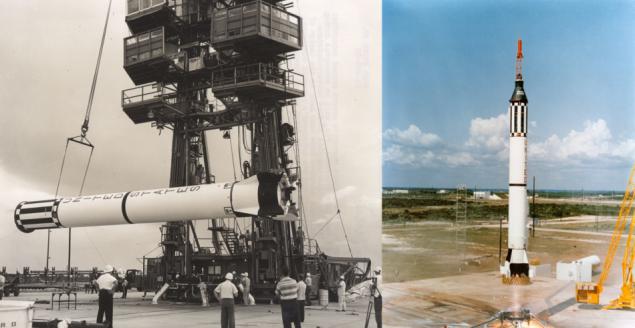
Booster "Redstone", the full name of «Mercury-Redstone Launch Vehicle» - is modified for manned flights BRSD «PGM-11 Redstone», a direct descendant of "V-2" development team Wernher von Braun. In the combat version of the missile was carrying a thermonuclear warhead, space options used to launch the first US satellites and other space programs. Starting weight up to 30 tons, diameter 1, 78 m, length 25, 4 m.
astronaut h5> 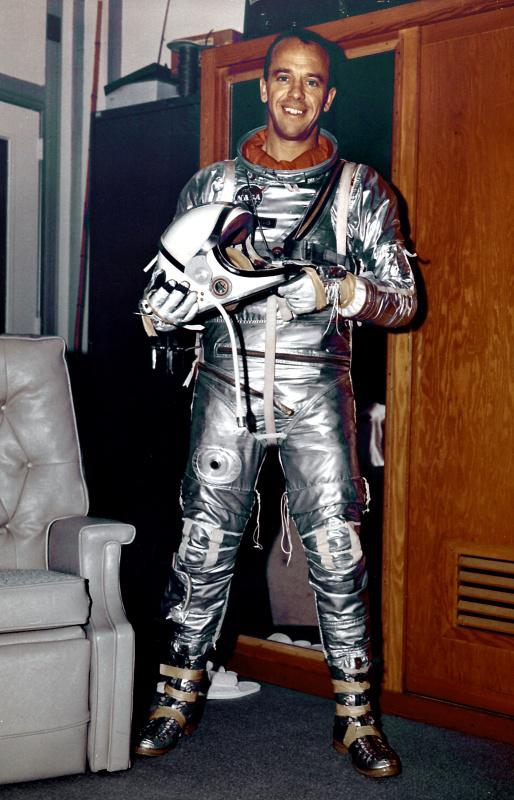
Alan Bartlett Shepard, Jr., was born November 18, 1923, died July 21, 1998. He graduated from the Naval Academy in Annapolis, served on a destroyer during World War II. After the war, went to the pilots, became a test pilot and in 1959 became one of the seven US astronauts first set. Height 180 cm, weight 77 kg.
Status of Mission h4> originally planned to start on May 2nd. Shepard and his backup Grissom and Glenn woke up in the morning, had breakfast and waited for the team to leave the start. But because of the weather conditions start canceled. A second attempt was made on May 5. Shepard took place in the ship two hours before the start, at 5:15 am ET. At 7 am start was postponed for an hour due to clouds - clouds prevented observations missiles, and it was necessary to clear skies for earth observation. Then the inverter is overheated and had to play off the excess pressure in the oxygen tank. Start already delayed by two hours. There was a problem that I did not consider any engineers or doctors - for the flight, which was supposed to last only fifteen minutes, no one thought about the sanitary needs of an astronaut. Simply put, in a spacesuit absent urinal. More than four hours of waiting in a rocket, not including travel time, etc. have led to the fact that the first American astronaut had to urinate in the suit with the risk of a short circuit. But nothing terrible happened. Shepard with humor took the situation, calling himself "wet back» abbr> and called PCO "to solve their problems, and finally to light this candle." As a result, the start took place at 9:34 ET. Start watched live from 45 to 70 million people, more simply, the whole of America. The schools were stopped classes, institutions have stopped working, even the traffic has stopped - all followed the leap into space.
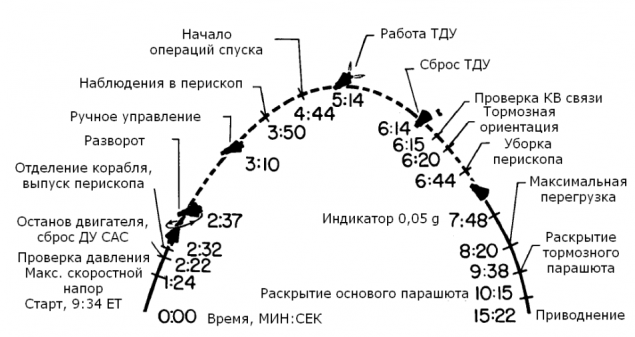
time (MM: SS) th> Event th> Description th> 00:00 Start Start, start the ship's clock. 00:16 Program pitch < Booster reduces the pitch from 90 to 45 degrees at a speed of 2 m / sec. 00:40 End of program pitch Booster reaches the pitch angle of 45 degrees. 01:24 Max Q Maximum speed pressure (28 kPa). 02:20 BECO Turning off the engine (Booster Engine CutOff), the speed of 2.3 km / s. < / 02:22 Reset controller SAS tower Cleared emergency rescue system. 02:24 Office Engines division was added 4.6 m / s. 02:35 Turn Cruise ship astern unfolds and exposes the pitch angle -34 degrees (nose down). 05:00 < Apogee Apogee height of 185 km, the distance from the start to 240 km. 05:15 Braking td > Three solid engine brake work every 10 seconds. The interval between starts 5 seconds, their work is superimposed on each other. The speed is reduced by 155-170 m / 05:45 Cleaning periscope Periscope is automatically removed in preparation for entry into atmosphere 06:15 Reset SFT minutes after braking brake motors are reset, not to close the heat shield. 06:20 Brake orientation Cruise ship focuses on entering the atmosphere stern back up his nose. 07:15 0.05 g i> (0.5 m / s²) autopilot captures the atmosphere and the beginning of the spins to stabilize the ship. 09:38 The brake parachute Expands drag chute, height 6, 7 km, the speed slows to 111 m / s. 09:45 Breather to open the valve for venting fresh air and height of 6, 1 km . Life support system includes emergency ventilation to cool the cabin. 10:15 The main parachute Opens the main parachute, the height of 3 km, the rate of decline falls to 9, 1 m / with. 10:20 Planting shock Expands planting shock height of 1 m 2 tr > 10:20 Reset Fuel Automatically vented remaining fuel system orientation. 15:30 Splashdown Ship splashed approximately 480 km from the start. 15:30 Disclosure Rescue System Expands System for Search and Rescue - green dye in the water, and a beacon antenna. Flight plan was painted literally in seconds, and there were the following experiments:
Manual orientation. Shepard checked the possibility and ease of orientation along the three axes - pitch, roll and yaw. Earth Observation. In periscope Shepard watched the earth and said that the Earth can be seen well, you can recognize the great lakes, islands and other landscape elements. Observations missiles. The rocket should not be far away, but, nevertheless, it did not see Shepard. However, the "Mercury" was a very bad review, so it's no surprise. The observations of the stars. Shepard had to watch the star / planet in the viewing window. Unfortunately, because of the strong background light, he saw nothing. Attempts to see the stars have led to the fact that it is slightly behind schedule, and for the first time, in his own memoirs, nervous.
Faults:
During the flight there was only one notable failure - denied sensor reset TDU. On the dashboard was able to reset the operation - a push of a button to tell the system that the operation took place than Shepard and used. In the book «The Right Stuff» Wolfe argues that Shepard forgot to remove the filter reduces the brightness of the periscope before the start, and decided not to take it off then, so he could see through the periscope black and white low-contrast image, and not quite sincerely DVGA said, "What a beautiful view." But confirmation of this information from other sources I have not found, the authenticity of this is unknown.
Videorekonstruktsiya h4> Clip, laid out on YouTube, uses the following items Sources:
Land camera shoots missile launch. The camera removes astronaut. The camera removes the dashboard. Upgrade flight in Orbiter. I have repeatedly appealed to the author with a request to add a video made by me in his movie subtitles. For some unknown reason, he did not answer me, so I had to do is not very nice - copy the video and add Russian subtitles. Link to the original video is on the video page in YouTube, there is a built-in English subtitles, if anyone is interested. Video recommend open in a separate tab and expand to full screen.
There are More video of another author , but there are fewer sources.
If you like the idea of such a reconstruction, I recommend to pay attention to the similar reconstruction Gagarin's flight .
Information Sources h4> Besides Wikipedia the following sources:
"World manned space program. History. Appliances. People ", ed. Yu.M.Baturina, M .: "RTSoft", 2005
Tom Wolfe «The Right Stuff».
data Shepard Online NASA - height and weight from there.
Source: habrahabr.ru/post/227083/
The history of portable gaming consoles. Part 1 (Before 2000)
The wall of the box: DARPA placed an order for samovozvodimoe obstacle



























